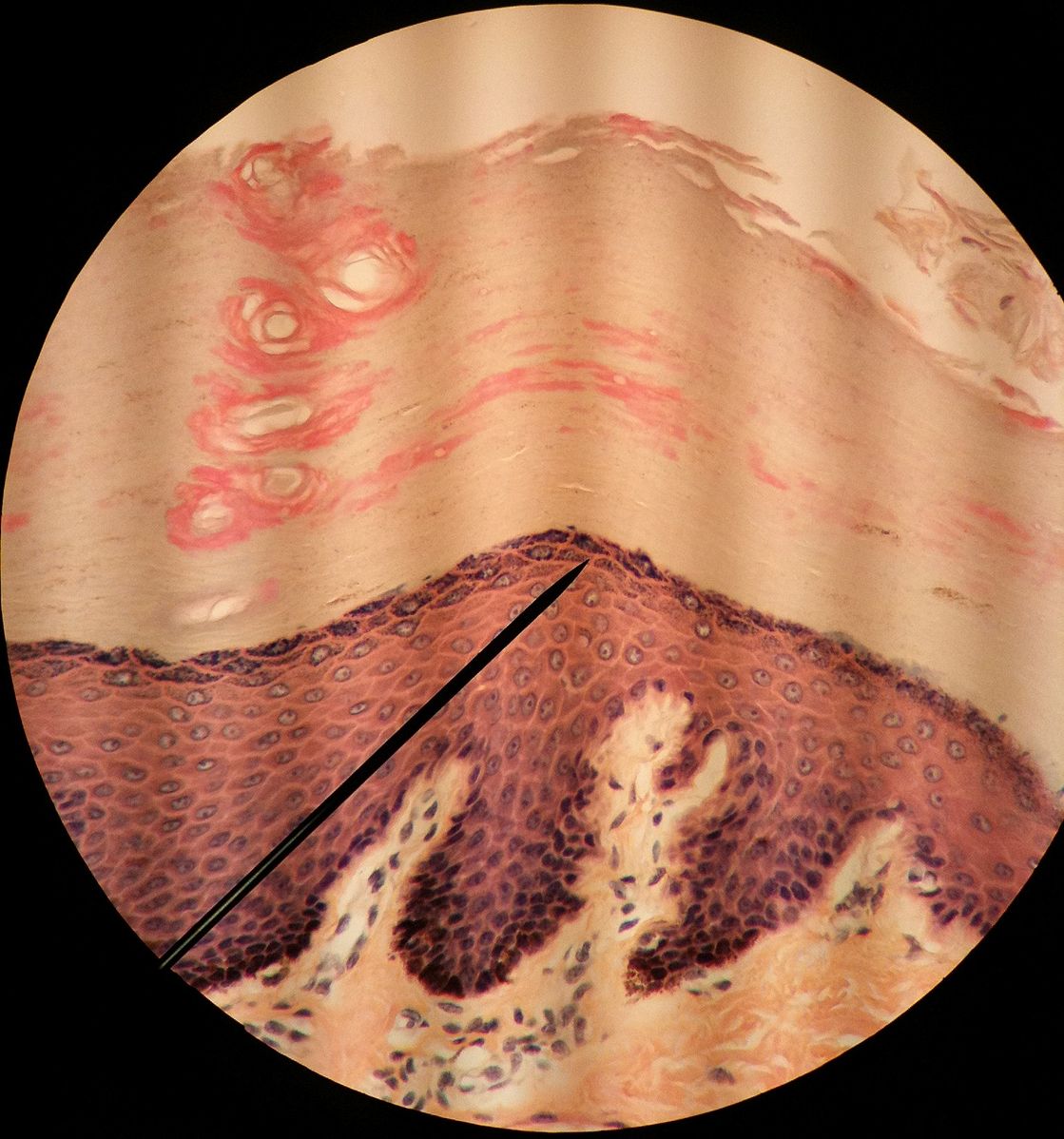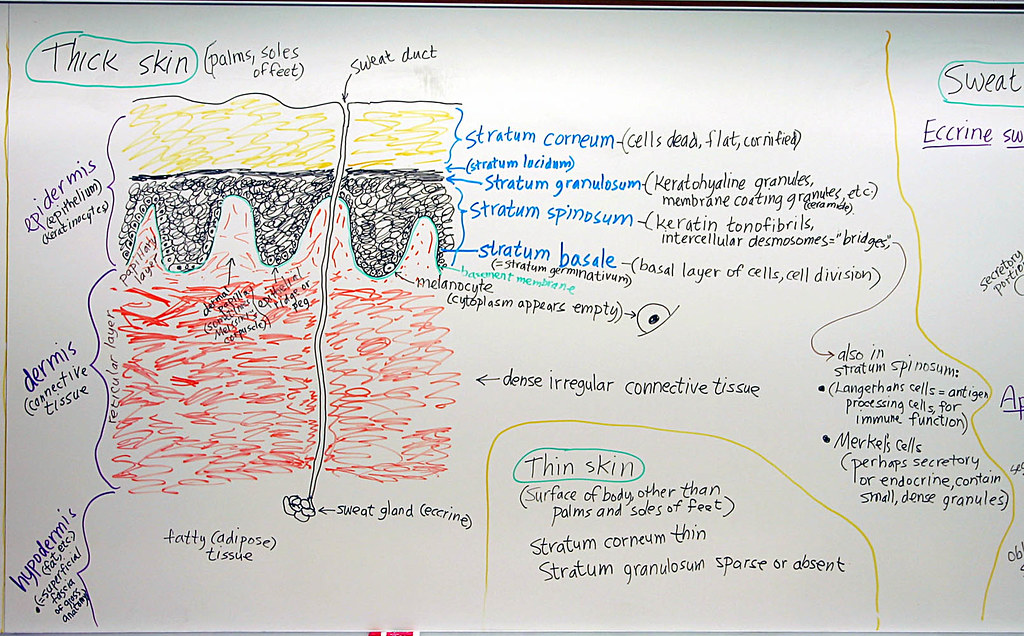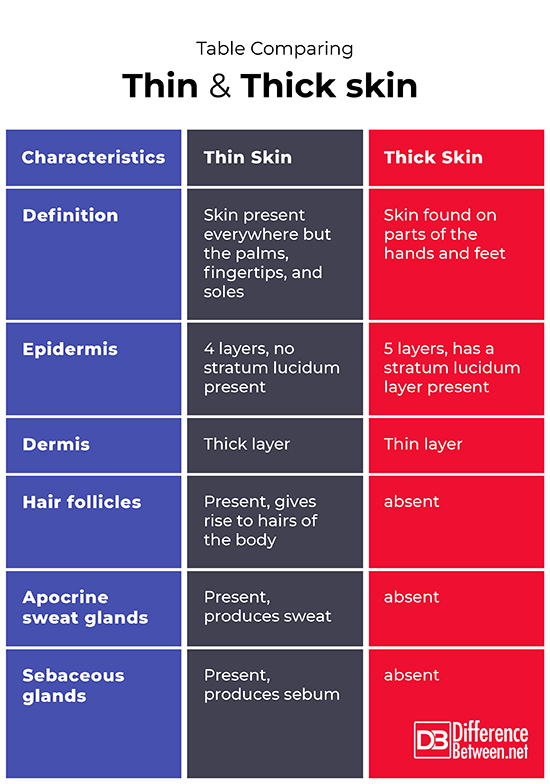Difference Between Thin and Thick Skin
Thin skin is the main type of skin found covering most of the body. Thick skin is the type of skin only found on the fingertips, palms of the hands, and soles of the feet.

What is Thin skin?
Definition:
Thin skin is the type that is found covering most parts of the body excluding certain parts of the hands and feet. It does also vary in thickness with the thinnest layers being found in areas such as the eyelids, for instance.
Appearance:
Thin skin looks the same as thick skin when viewed macroscopically. However, there are microscopic histological differences between the two types of skin. One of the most obvious visible differences is the lack of a stratum lucidum layer in the epidermis and the presence of several glands and hair follicles in thin skin.
Structures present in thin skin:
There are many structures we find in thin skin that are not found in thick skin. Thin skin has hair follicles, sebaceous glands, and sweat glands present. Hair follicles produce the actual hairs of the body and the head. The sebaceous glands are always associated with hair follicles and have an important role as they secrete an oily type of substance called sebum. Sweat glands occur throughout the thin skin and produce the sweat of the body. How many glands, the functioning of glands and even the type of hair, varies with stage of development.
Functions:
The thin skin protects the body from invasion by pathogens and it produces sweat which helps to not only cool the body but also has antimicrobial properties. Sweating is, however, limited in children younger than about 24 months. This type of skin also contains hair follicles which produce different types of hair depending on where the follicles occur on the body. In other words, body hair is slightly different from head hair and has different development rates. The sebum produced by the sebaceous gland has an important role in helping to lubricate the hairs produced by the hair follicles.

What is Thick skin?
Definition:
Thick skin is a particular type of skin only found in certain regions of the body, namely on the fingertips, soles and palms, where there is a need for greater protection.
Appearance:
Thick skin has more epidermal layers present, and in fact, has a stratum lucidum layer present. This particular layer consists of dead cells and it is not found in thin skin at all. In fact, thick skin is lacking many of the structures that are present in thin skin. Thus, morphologically it is different in appearance when viewed through a microscope.
Structures present in thick skin:
Thick skin is lacking the sweat and sebaceous glands, and the hair follicles that are present in thin skin. However, thick skin does have a layer called the stratum lucidum, which is not found in thin skin. It occurs between the outermost layer of the epidermis, called the stratum corneum and a lower layer, called the stratum granulosum. The stratum lucidum often contains a substance called eleidin, which is a form of keratin.
Functions:
Thick skin also helps defend the body from pathogens and forms part of the nonspecific defenses of the body. This type of skin is designed to protect the body from damage where there is a lot of abrasion and friction, which is why it is found in areas that grip surfaces, namely the feet and hands.
Difference between Thin and Thick skin?
Definition
Thin skin is the name given for skin covering most of the body except certain places. Thick skin is the name used for skin that is only found covering the soles of the feet and the palms and fingertips of the hand.
Epidermis
The epidermis of the thin skin contains only four layers and there is no stratum lucidum present. The epidermis of the thick skin consists of five layers including a stratum lucidum layer found between the stratum corneum and stratum granulosum layers.
Dermis
The thin skin has a relatively thick dermis layer. The thick skin has a relatively thin dermis layer.
Hair follicles
Thin skin contains hair follicles that give rise to hair of the body and head. Thick skin has no hair follicles present and thus no hair is produced where this skin type is present.
Apocrine sweat glands
Thin skin contains several apocrine sweat glands that produce sweat. Thick skin does not contain apocrine sweat glands.
Sebaceous glands
Sebaceous glands are found throughout the thin skin where they are positioned next to the hair follicles. Sebaceous glands are absent from the thick skin.
Table comparing Thin and Thick skin

Summary of Thin vs. Thick skin
- Thick and thin skin looks the same at a macroscopic level.
- Both thin and thick skin has an epidermis and a dermis but the structures found and relative sizes of the layers may differ.
- Thin skin has many structures present that are absent in thick skin.
- Thick skin does have an extra epidermal layer called the stratum lucidum, which is absent in thin skin.
- The function of thick skin is mainly to prevent damage due to abrasion and friction.
- The thin skin also functions in protection, but also produces hairs, sweat, and sebum.
- Difference Between Rumination and Regurgitation - June 13, 2024
- Difference Between Pyelectasis and Hydronephrosis - June 4, 2024
- Difference Between Cellulitis and Erysipelas - June 1, 2024
Search DifferenceBetween.net :
1 Comment
Leave a Response
References :
[0]Image credit: https://live.staticflickr.com/7184/6979274395_ebdfc9cabc_b.jpg
[1]Image credit: https://commons.wikimedia.org/wiki/File:Thick_Skin_Histological_Section_(epidermis,_dermis_and_hypodermis).jpg
[2]Arda, Oktay, Nadir Göksügür, and Yalçın Tüzün. "Basic histological structure and functions of facial skin." Clinics in dermatology 32.1 (2014): 3-13.
[3]Boer, Magdalena, et al. "Structural and biophysical characteristics of human skin in maintaining proper epidermal barrier function." Advances in Dermatology and Allergology/Postȩpy Dermatologii i Alergologii 33.1 (2016): 1.
[4]Montagna, William and John G. Ebling. “Human skin”. Encyclopedia Britannica. Encyclopedia Britannica, 2020, https://www.britannica.com/science/human-skin

Hello, why some sites ( this one for example ) says that sweat glands are not present in thick skin, but my textbook ( Inderbir ) says that they are present in dermis ?